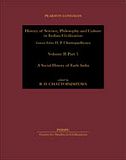Social History of Early India
Chattopadhyaya, Brajadulal (Hrsg.):
A social history of Early India / ed. by B. D. Chattopadhyaya. - Delhi : Pearson Longman ; New Delhi : Centre for Studies in Civilizations, 2009. - XLIX, 305 S. - (History of science, philosophy and culture in Indian civilization ; Vol. 2: Life, thought and culture in India ; Pt. 5)
ISBN 978-81-3171958-9
Rs. 1400,00
US$ 56,50 (Biblia Impex)
US$ 57,65 (D.K. Agencies)
Beschreibung
For a long time, the writing of the social history of early India was under the influence of colonial historiography. Dichotomous categories that were nineteenth-century inventions, such as Aryan-non-Aryan, were the norm. There was heavy reliance on empirical data, collected from texts that had partial or normative descriptions, multiple authorship, and a complex evolution. Though archaeological and oral sources indicated otherwise, social history perforce was equated with the literate phase. Also, an ambiguity about the very idea of ‘social history’ was evident in the tendency to see the ‘social’ as something separate from ‘history’. Later works, however, tried to integrate advances made in archaeology. New approaches and methodologies were used. Attention was paid to marginalized groups and to the living traditions, their evolution and impact. This volume introduces readers to several specific dimensions of Indian society in its formative stage. The aim is to present an integrated approach in which polity, economy, religion and society can all be seen as different, constantly interacting spaces within a society subject to transformation. The diverse themes in the volume range from perceptions of the country—very much a social expression—to modes of communication and popular culture. The volume seeks to explore new thinking and new research on social history, thus underlining the need to incorporate such themes as ‘urban’ attitudes, gender history, and popular culture into all future projects on early Indian social history. At the same time, the centre space is that of varòa-jâti, representing an oppressive social system of inequality and exclusion, which dwells on how the system may have originated, the ideological implications of the system and Brâhmaòical perception of what deviation from the system might entail. This important volume, containing incisive essays reflecting the change in the way the past of India is looked at, will be invaluable for teachers, scholars and students of Indian history. [Verlagsinformation]
Inhalt
I. THE ARCHAEOLOGICAL BACKGROUND
1. Nayanjot Lahiri: Archaeological and some aspects of the social history of early India. 3
II. EARLY PERCEPTIONS OF INDIA AND ITS PEOPLES
2. N. N. Bhattacharya: India: its regions and peoples. 21
3. R. Mahalakshmi: Cankam literature as a social prism: an interrogation. 29
4. Bhairabi Prasad Sahu: Brahmanical conception of the origin of Jātis: a study f the Manusmṛti. 43
III. SOCIAL PROCESSES
5. Chitrarekha Gupta: Social Processes: the historical and chronological framework. 55
6. P. K. Basant: Urbanism and society in early India. 73
IV. POWER AND AUTHORITY
7. Sibesh Bhattacharya: Power and authority in early India. 93
V. BELIEFS PRACTICES AND SOCIAL INTERNALIZATION
8. Parnasabari Bhattacharya: Beliefs, practice and social internalization in modes of daily living. 117
VI. MODES AND SPACES OF INTERACTION
9. Ranabir Chakravarti: Relationships and interactions in the economics sphere. 129
10. Upinder Singh: Brāhmaṇa settlements in ancient and early medieval India. 157
VII. RELIGION AND SOCIETY MOVEMENTS AND COMMUNICATIONS
11. R. N. Nandi: Religious Developments in North India. 179
12. Rajan Gurukhal: Temples as sites of social and religious interaction. 196
VIII GENDER ISSUES
13. Kumkum Roy: Gender relations during in first millennium : an overview. 213
14. Vijaya Ramaswamy: Gender and transcendence in early India. 233
IX. ART AND SOCIETY
15. Shanada Srinivasan: Early social history of Indian metal crafts: some archaeometallurgical and ethnoarchaeological perspectives. 251
X. POPULAR CULTURE
16. Agni Kumar Hota: Modes of Articulation of Popular Culture in Early India. 269
Herausgeber
B. D. Chattopadhyaya was educated at the University of Calcutta, and later, obtained his Ph.D at Cambridge. He taught, till his retirement in 2004, at the Centre for Histotical Studies, Jawaharlal Nehru University, New Delhi.
Quellen: Longman Pearson; WorldCat; D.K. Agencies; Biblia Impex
Ähnlich
- Newbigin: The Hindu Family and the Emergence of Modern India
- Ikegame: Princely India Re-imagined
- India in Britain
- The Government of Social Life in Colonial India
- Slavery, Abolitionism and Empire in India
- Low and licentious Europeans
- Codes of Misconduct
- Llewellyn-Jones: Last King in India
- After Timur Left
- Viswanath: The Pariah Problem

